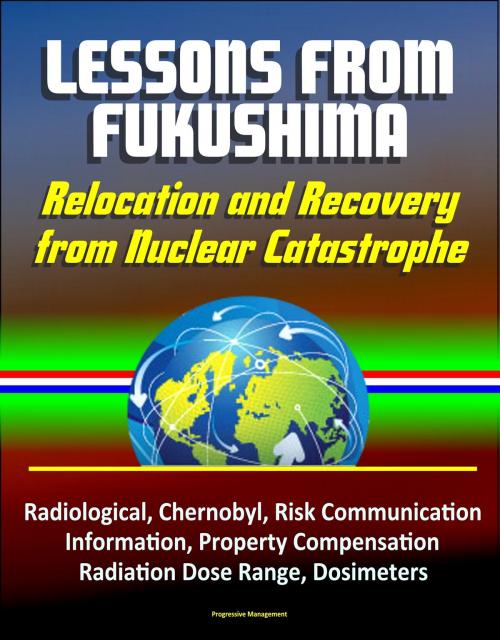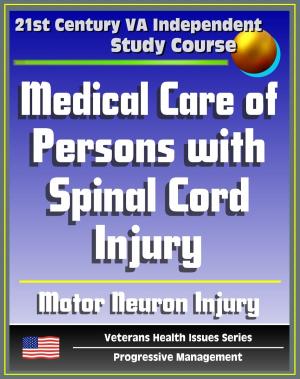Lessons from Fukushima: Relocation and Recovery from Nuclear Catastrophe - Radiological, Chernobyl, Risk Communication, Public Information, Property Compensation, Radiation Dose Range, Dosimeters
Nonfiction, Science & Nature, Science, Physics, Radiation, Technology, Nuclear Energy| Author: | Progressive Management | ISBN: | 9781311746269 |
| Publisher: | Progressive Management | Publication: | March 6, 2016 |
| Imprint: | Smashwords Edition | Language: | English |
| Author: | Progressive Management |
| ISBN: | 9781311746269 |
| Publisher: | Progressive Management |
| Publication: | March 6, 2016 |
| Imprint: | Smashwords Edition |
| Language: | English |
Professionally converted for accurate flowing-text e-book format reproduction, the objective of this study was to assess lessons the United States can incorporate into its disaster management plans from Japan's experience managing the relocation of communities due to the widespread contamination from the Fukushima Daiichi nuclear plant. Four years after the catastrophe, Fukushima Prefecture estimates 119,000 residents are still living in temporary accommodations while remediation work continues in 11 municipalities.
This comparative analysis of the Fukushima case approached the challenge of planning for recovery after a nuclear/radiological disaster from the perspective of managers with limited radiation management expertise. It examined the progress of recovery in the first four years and the management practices related to the relocation and resettlement of the most contaminated Fukushima communities. The primary recommendation is that states and communities require guidance and tools to use both to prepare for major radiological incidents and as post-incident job aids for managing disaster recovery. Leaders and planners will be able to apply the study's detailed recommendations to enhance efforts to prepare for the intermediate and late-phase recovery from radiological disasters.
CHAPTER I * INTRODUCTION * A. RESEARCH QUESTIONS * B. PROBLEM SPACE * C. SUMMARY OF METHOD * D. SIGNIFICANCE TO THE FIELD * E. OVERVIEW OF CHAPTERS * CHAPTER II * LITERATURE REVIEW * A. NUCLEAR/RADIOLOGICAL RECOVERY PLANNING AND MANAGEMENT * B. CHERNOBYL RECOVERY * C. COMPARING FUKUSHIMA TO CHERNOBYL * D. RISK COMMUNICATION * 1. Public Trust * 2. Individual Perception of Risk * 3. Risk Communication in Disaster Management Practice * E. SUMMARY AND NEED FOR FURTHER RESEARCH * CHAPTER III * METHOD * A. UNIT OF ANALYSIS * B. CASE SELECTION * C. LIMITATIONS OF THE STUDY * D. DATA SOURCES * E. TYPE AND MODE OF ANALYSIS * F. OUTPUT * CHAPTER IV * RELOCATION AND RECOVERY AFTER THE FUKUSHIMA NUCLEAR ACCIDENT * A. INTRODUCTION * B. JAPAN'S DISASTER MANAGEMENT SYSTEM * 1. Nuclear Power Regulation and Emergency Preparedness * 2. Concept of Operations for Nuclear Emergencies * C. OVERVIEW OF INCIDENT, IMMEDIATE RESPONSE AND EVACUATIONS * 1. Cascading Catastrophe * 2. The Evacuation * D. PUBLIC INFORMATION/RISK COMMUNICATION * 1. Public Information for Dispersed Residents * 2. Public Trust * 3. Environmental Radiation Standards * 4. Discrimination and Stigma * E. RECOVERY PLANNING AND MANAGEMENT STRUCTURE * 1. National Planning and Legal Frameworks For Recovery * 2. Prefectural and Municipal Planning * F. FINANCIAL ASSISTANCE * 1. Governmental Disaster Assistance * 2. TEPCO Compensation * G. TEMPORARY HOUSING * H. OFFSITE REMEDIATION * I. COMMUNITY RESETTLEMENT * J. SUMMARY OF FUKUSHIMA CASE DESCRIPTION * CHAPTER V * COMPARATIVE ANALYSIS * A. KEY PRACTICES - PUBLIC INFORMATION/RISK COMMUNICATION * B. KEY PRACTICES - RECOVERY PLANNING AND MANAGEMENT STRUCTURE * C. KEY PRACTICES - FINANCIAL SUPPORT * D. KEY PRACTICES - TEMPORARY HOUSING * E. KEY PRACTICES - OFFSITE REMEDIATION * F. KEY PRACTICES - COMMUNITY RESETTLEMENT * G. APPLICABILITY TO THE U.S. POLICY ENVIRONMENT * 1. Political and Governmental Structure * a. Nuclear Liability and Compensation in the U.S. * b. U.S. Planning Guidance and Gaps * 2. Geographical and Cultural * H. COMPARATIVE ANALYSIS SUMMARY * CHAPTER VI * RECOMMENDATIONS AND CONCLUSION * A. POLICY RECOMMENDATIONS * B. OPPORTUNITIES FOR FUTURE RESEARCH * 1. Real Property Compensation Policy Impact * 2. Radiation Dose Range * 3. Personal Dosimeters for Estimating Future Dose * 4. Compensation Guidelines * 5. Staged Reoccupancy in "Base Settlements" * C. CONCLUSION * LIST OF REFERENCES
Professionally converted for accurate flowing-text e-book format reproduction, the objective of this study was to assess lessons the United States can incorporate into its disaster management plans from Japan's experience managing the relocation of communities due to the widespread contamination from the Fukushima Daiichi nuclear plant. Four years after the catastrophe, Fukushima Prefecture estimates 119,000 residents are still living in temporary accommodations while remediation work continues in 11 municipalities.
This comparative analysis of the Fukushima case approached the challenge of planning for recovery after a nuclear/radiological disaster from the perspective of managers with limited radiation management expertise. It examined the progress of recovery in the first four years and the management practices related to the relocation and resettlement of the most contaminated Fukushima communities. The primary recommendation is that states and communities require guidance and tools to use both to prepare for major radiological incidents and as post-incident job aids for managing disaster recovery. Leaders and planners will be able to apply the study's detailed recommendations to enhance efforts to prepare for the intermediate and late-phase recovery from radiological disasters.
CHAPTER I * INTRODUCTION * A. RESEARCH QUESTIONS * B. PROBLEM SPACE * C. SUMMARY OF METHOD * D. SIGNIFICANCE TO THE FIELD * E. OVERVIEW OF CHAPTERS * CHAPTER II * LITERATURE REVIEW * A. NUCLEAR/RADIOLOGICAL RECOVERY PLANNING AND MANAGEMENT * B. CHERNOBYL RECOVERY * C. COMPARING FUKUSHIMA TO CHERNOBYL * D. RISK COMMUNICATION * 1. Public Trust * 2. Individual Perception of Risk * 3. Risk Communication in Disaster Management Practice * E. SUMMARY AND NEED FOR FURTHER RESEARCH * CHAPTER III * METHOD * A. UNIT OF ANALYSIS * B. CASE SELECTION * C. LIMITATIONS OF THE STUDY * D. DATA SOURCES * E. TYPE AND MODE OF ANALYSIS * F. OUTPUT * CHAPTER IV * RELOCATION AND RECOVERY AFTER THE FUKUSHIMA NUCLEAR ACCIDENT * A. INTRODUCTION * B. JAPAN'S DISASTER MANAGEMENT SYSTEM * 1. Nuclear Power Regulation and Emergency Preparedness * 2. Concept of Operations for Nuclear Emergencies * C. OVERVIEW OF INCIDENT, IMMEDIATE RESPONSE AND EVACUATIONS * 1. Cascading Catastrophe * 2. The Evacuation * D. PUBLIC INFORMATION/RISK COMMUNICATION * 1. Public Information for Dispersed Residents * 2. Public Trust * 3. Environmental Radiation Standards * 4. Discrimination and Stigma * E. RECOVERY PLANNING AND MANAGEMENT STRUCTURE * 1. National Planning and Legal Frameworks For Recovery * 2. Prefectural and Municipal Planning * F. FINANCIAL ASSISTANCE * 1. Governmental Disaster Assistance * 2. TEPCO Compensation * G. TEMPORARY HOUSING * H. OFFSITE REMEDIATION * I. COMMUNITY RESETTLEMENT * J. SUMMARY OF FUKUSHIMA CASE DESCRIPTION * CHAPTER V * COMPARATIVE ANALYSIS * A. KEY PRACTICES - PUBLIC INFORMATION/RISK COMMUNICATION * B. KEY PRACTICES - RECOVERY PLANNING AND MANAGEMENT STRUCTURE * C. KEY PRACTICES - FINANCIAL SUPPORT * D. KEY PRACTICES - TEMPORARY HOUSING * E. KEY PRACTICES - OFFSITE REMEDIATION * F. KEY PRACTICES - COMMUNITY RESETTLEMENT * G. APPLICABILITY TO THE U.S. POLICY ENVIRONMENT * 1. Political and Governmental Structure * a. Nuclear Liability and Compensation in the U.S. * b. U.S. Planning Guidance and Gaps * 2. Geographical and Cultural * H. COMPARATIVE ANALYSIS SUMMARY * CHAPTER VI * RECOMMENDATIONS AND CONCLUSION * A. POLICY RECOMMENDATIONS * B. OPPORTUNITIES FOR FUTURE RESEARCH * 1. Real Property Compensation Policy Impact * 2. Radiation Dose Range * 3. Personal Dosimeters for Estimating Future Dose * 4. Compensation Guidelines * 5. Staged Reoccupancy in "Base Settlements" * C. CONCLUSION * LIST OF REFERENCES















